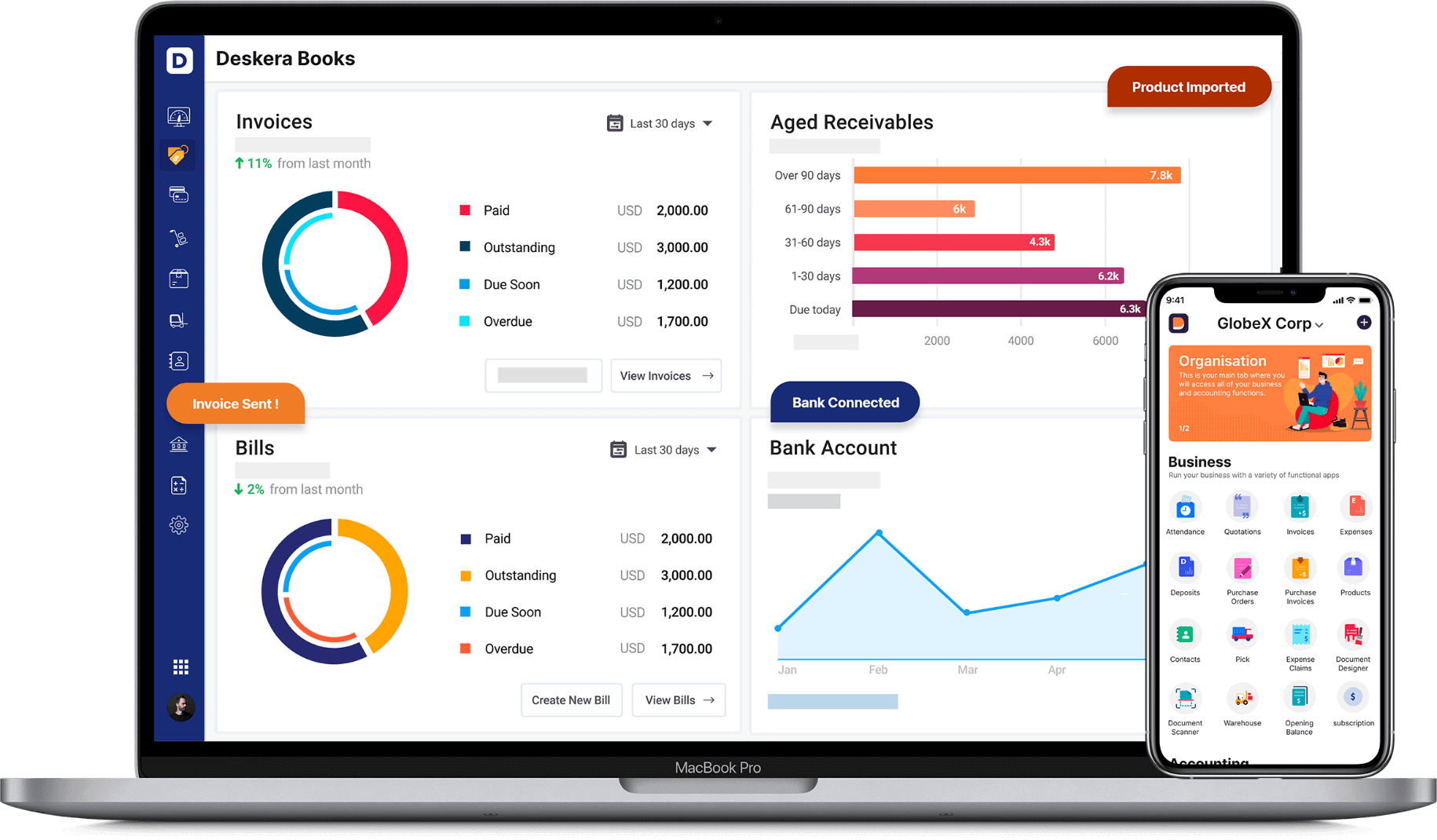Being a business owner does not mean you will only have to count profit, it means you have to keep a check on all the operations running in your company. From maintaining customer relationships to knowing the manufacturing or service providing process to understanding the financial and accounting operations of your company, all comes under your hat as a business owner.
Yes, it can sound a lot at times, let's just take one thing at a time. As a business owner, you are responsible for keeping a clean and fine record of all the financial transitions taking place in your company. Yes, you can hire an accountant and a bookkeeper, but learning about the process is important for you too.
Did you know? All the income that your company makes does not directly go into your revenue account? Don’t be shocked, there are other forms of revenue that you might have received but not have earned yet. Such revenue is called Deferred revenue.
What will you find in this article?
- What is Deferred Revenue?
- Examples of Deferred Revenue
- When to Convert Deferred Revenue to Income Revenue
- Deferred Revenue and Accrual Accounting
- How to Calculate and Record Deferred Revenue on the Balance Sheet
- Deferred Revenue Vs Deferred Expenses
- Frequently Asked Questions
- Key Takeaways

What is Deferred Revenue?
When a company receives an advanced payment(s) for services or products that the customer hasn't received yet, the income earned from it is called deferred revenue. This form of revenue is also known as unearned revenue or default income because the company owes service to its clients.
On their balance sheet — a financial document keeping a record of the company's assets, debts, liabilities, equities, etc., companies record this payment as a liability, a prepayment. So accounting it as a liability is reasonable because the company is still obligated to pay for services to its customer.
Adding this revenue directly to its sales revenue could lead to incorrect accounting if the company fails to deliver its services due to unforeseen circumstances. Or the customer is no longer interested in the product. In any of those cases, the company has to pay back its client unless there is an agreement signed between the two parties.
Thus, understanding deferred revenue and how to keep a record is a mindful task for a business. To help you with proper accounting practice so that you don’t mess up your finances, let us understand deferred revenue with an example.

Example of Deferred Revenue
One of the simplest examples you see of deferred revenue is annual magazine subscriptions. Mike has a business that provides kids’ magazines annually for $120 ($10 for a magazine). Mike’s new customer Lara subscribes to the plan on the 1st of January for her daughter and pays the complete amount upfront. Yes, the services or books are yet to be delivered.
Upon receiving the payment, Mike will have to record it as default revenue, on the company’s balance sheet. Once Mike provides the first magazine, $10 will no longer be Mike’s deferred revenue. You will also debit that $10 from the deferred revenue account and credit it to the sales account.
Now, for the upcoming months, each time Mike delivers a magazine to Lara, Mike will transfer $10 from the deferred revenue account to the company’s income account. After completion of the year, $120 will be added to the company’s income account.

Some more live examples of deferred revenue -
Service Contracts
All service-based contracts seek advance payment from the client. The services can be provided for a long or a short period in the future. This revenue is counted as deferred revenue as the amount received is yet to be earned. The amount will be earned as and when the services are provided.
Advance Rent
Brokers and landlords always deal in advance payment. Be it a residential property or a commercial property, in most cases, the tenant has to pay the rent as soon as the contract is signed. The advance amount can be for a few months of rent for a few years depending on the terms of the contract.
Tickets
Event tickets are always sold in advance. The revenue received from the sale is only earned after the event has happened. The amount can be received months in advance. Till the time the event happens, the revenue is counted as deferred revenue.
Online Retailers
When a customer buys a product online and chooses an online payment option, the retailer receives money instantly. However, the amount is not counted as income until the customer has received the product or the services. This can take a few hours or a few days depending on the kind of product and service.
When to Convert Deferred Revenue to Income Revenue
The deferred revenue is transferred to the revenue account once the money is earned. This can be subjective depending on several factors. Every business runs on its own terms. Based on the agreement with the customers, companies take a different approach to finalizing deferred revenue to income revenue. But all companies have to follow Generally Accepted Accounting Principles (GAAP), which are issued by Financial Accounting Standards Board (FASB).
Broadly, there are two types of accounting recording in this case. A company can choose anyone depending on the agreement.
Percentage of Completion
In this method, a company debits money from the unearned revenue account and credits it into the income account on the basis of the percentage of work or service delivered. As we saw in the example of the magazine subscription, after delivering one magazine to Lara, $10 was credited into the income account. Here, $10 is equal to the service completed. The process goes on with the delivery of the magazine each month.
Completed Contract Completion
As the name implies, in a completed contract, there is a contract signed between both parties. Once you deliver your complete goods or services to your customers, you receive your payment. Even though the amount has been received in advance, it will be credited to the income account after the completion of delivery.
Deferred Revenue and Accrual Accounting
Every company runs on different rules. A lot of times the rules are bent as per the need of the customer. In a wider case, for example, an individual service provider or a retail shopkeeper can change its process of payment as per their wish. They can charge an upfront advance, partial advance payment, or complete payment after the delivery of goods or services.
Some companies work with the same methods as well. As a result, they have to use different kinds of accounting systems as well.
So what if you don’t receive any upfront payments? Rather, your customers want you to deliver your services and then get paid for them. This is possible and becomes a part of accrual accounting. Here the customer pays once they receive full service or goods. In this type of accounting the money is directly credited to your sales account and becomes a part of the asset. On the other hand, with deferred revenue, as discussed earlier, payment is received earlier before the goods and marked as a liability.
The process is simple, you won’t have to confuse the two.
How to Calculate and Record Deferred Revenue on the Balance Sheet
Alright, by far we have discussed almost everything there is to know, understand and learn about deferred revenue. But understanding things, in theory, is a lot different from how it works practically.
Yes, you understand that the deferred revenue account is credited for receiving the amount. It is then debited with the same amount when the money is earned and the amount is credited to the revenue account. Now, let’s see how do we actually make a journal entry of the same.
On a balance sheet, deferred revenues are recorded as current liabilities or long-term liabilities. Liability is a prepayment, and until you don’t offer your services, it doesn’t reflect your revenue on the income statement. But once you start providing services, the deferred revenue is not only counted as sales on your income statement but also becomes an asset.
Calculating deferred accounts is simple. Generally, there are two accounts: a deferred revenue and an income account or assets. When you receive an advance payment. Here is an example of how it works.
Stuart Taylor owns a dairy. A new customer comes to the dairy seeking a subscription for fresh milk. The cost of the subscription is $360 for 12 months. The customer pays the entire amount upfront. Now to accommodate the amount in your books you will have to make a journal entry.
Now since you have already received the subscription amount in advance it will be credited to the dairy’s cash account as the business’s cash has increased. The amount dairy has received is deferred revenue and it is credited to the deferred revenue account as the amount has increased here. The entry for the same will be.
Each month, the dairy is earning $30 after providing the fresh milk to the customer. This way, $30 is becoming the earning each month. To adjust this in the books, a deferred revenue account will be debited and the revenue account will be credited with $30. The journal entry for the same will be
Deferred Revenue Vs Deferred Expenses
As discussed multiple times already, deferred revenue is the revenue the company has received but is yet to earn. The services or goods against the money are yet to be delivered. A fine example of deferred revenue is receiving advance payment on rent or receiving advance money on the sale of tickets for any event.
Business is a separate entity and naturally has a lot of expenses. Like the business here works on the advance payment method, a lot of other businesses too follow the same. In the same way, a business has to pay in advance for the service they need in the coming future. To count some example rent for the operation space like office and warehouse. Another example can be the premium for insurance.
The two are similar but the receiving parties for the two are different that is what makes deferred payment and deferred revenue different.
Frequently Asked Questions
Why is deferred revenue a liability?
In simple terms, liability refers to prepayment. When you receive deferred revenue, you owe services to your customers. So you record it as a liability on your balance sheet. But once you deliver your services to your customer, deferred revenue becomes a part of your sales revenue.
What is the difference between deferred revenue and unearned revenue?
Deferred revenue or unearned revenue means the same thing. It is called unearned because you receive advance payment for the work you haven’t done. The revenue will be considered once the service or the goods are delivered. The accounts for unearned or deferred revenue and earned revenue are different as well.
When do you earn deferred revenues?
You earn your deferred revenue once you deliver your services/products to your customers on time. There are two ways you can account for this: percentage of work and contractual basis.
When you complete a percentage of work, the portion of your deferred revenue becomes sales revenue as you deliver your services. But on a contractual basis, you don’t count deferred revenue as income until you fully deliver your services to customers.
Why is deferred expense referred to as an asset?
An asset is something you receive after offering complete payment. Deferred expenditure is recorded on the balance sheet as an asset because that is something that has been paid a certain amount for. But it has not yet been fully used.
How can Deskera Help You?
Deskera Books can help you automate your accounting and mitigate your business risks. Creating invoices becomes easier with Deskera, which automates a lot of other procedures, reducing your team's administrative workload.

Learn about the exceptional and all-in-one software here:
Key Takeaways
Deferred Revenues are important to avoid misreporting for liabilities & assets. It is majorly important for those companies that work on the advance payment process. When a company receives advance payments for a service, it should add it as default income and consider the revenue as income after delivering the services successfully. If you fail to keep track of it, the new worth or total income of the company gets overstated, which could lead to improper finances and cause hindrance in the company’s growth.
Here are some of the most important points you should remember when understanding deferred revenue
-
Deferred revenue is the income that has been received but is not earned yet. You can understand it by advance payment for services and goods.
-
Deferred payment is recorded in a deferred payments account.
-
As and when the income is earned, in parts or in full, it has to be recorded in the company’s balance sheet as earned revenue or asset.
-
Deferred revenue is recorded in the business's balance sheet. The amount is credited in a deferred revenue account and the cash account of the company.
-
Once the amount is earned, the revenue account will be credited and the deferred payment account will be debited with the respective amount earned.
-
Deferred revenue is always treated as a liability since the money does not belong to the business yet.
Related Articles












